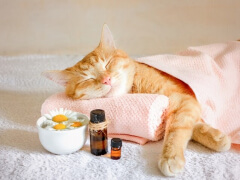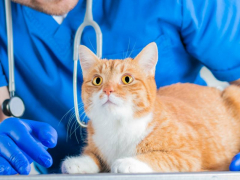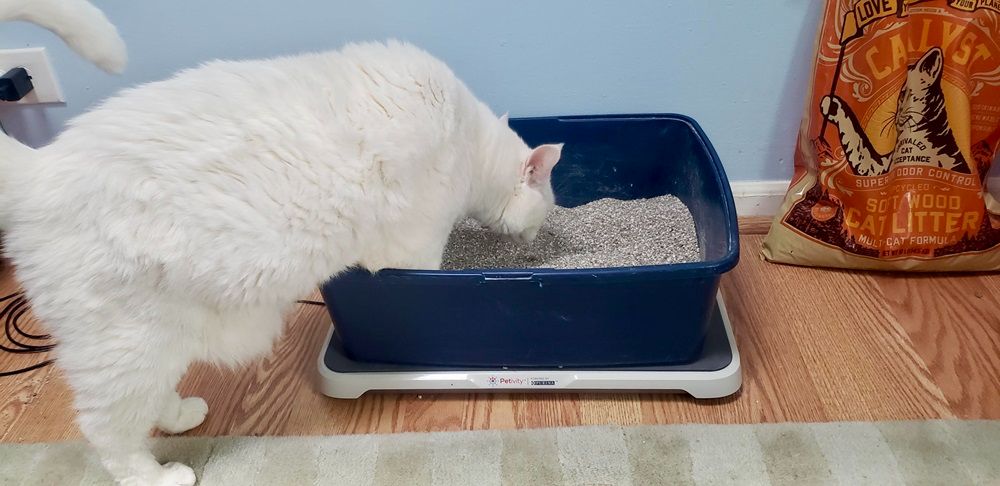
Liz Colmen / Cats.com
Cleaning out your cat’s litter box isn’t much fun, but keeping it clean and hygienic doesn’t just avoid unpleasant sights and smells—it can also prevent behavioral issues, and is vital for both your health and your cat’s.
A good rule of thumb is to scoop out your cat’s waste deposits twice daily and clean the litter box out completely every one to four weeks. In this article, we will help you decide how often to change your own cat’s litter by looking at factors such as the type of litter, the health of your cat, and the number of cats and litter boxes in your household.
Does the Type of Litter Affect the Changing Frequency?
Cat litter can be manufactured from many different materials including paper, wood, silica, clay, corn, sand, and wheat. There are two main types of cat litter—clumping and non-clumping—which differ in how they work, and how the litter box needs to be maintained.
Non-Clumping Litters
- Absorb large amounts of liquid
- Provide good odor control
- Require solid waste scooped out of the tray at least twice daily
- Should be completely emptied and cleaned at least weekly (more frequently if urine pools in the bottom of the tray, or if there is a noticeable smell)
Clumping Litters
- Absorb large amounts of liquid
- Provide good odor control
- Form solid lumps around urine and feces, which are easy to scoop out
- Require clumps scooped out at least twice daily, with fresh litter added to replace them
- Can be completely emptied and cleaned less frequently than with non-clumping litter, usually once every two to four weeks (more frequently if lots of the litter is wet or clumped, or if there is a noticeable smell)
What Litter Do Cats Prefer?
Guidelines on house soiling written by feline specialists advise that most cats prefer non-scented, fine, clumping, sand-like litter, at a depth of at least 1 inch. If you want to change the type of kitty litter you use, mix in the new one gradually over the course of at least a week.
Remember that cats are individuals though, and often have a strong preference for certain litter types, so you don’t always have the final say on litter choice.
How To Clean a Litter Box
Cleaning the litter box properly is a crucial part of ensuring your cat uses the box. When it is time for a full clean of the litter box:
- Throw away all remaining old litter.
- Wash the litter box with hot water and mild detergent or dish soap.
- Avoid using strongly scented chemicals, bleach, and anything containing ammonia, as they might put your cat off using the litter box.
- Dry the box thoroughly.
- Fill with enough new litter for your cat to be able to dig and bury their waste.
- Don’t forget to regularly clean your scoop, too.
- Ensure good hand hygiene by washing with soap and water after handling cat litter and supplies.
Why Might Cat Litter Need To Be Changed More Frequently?
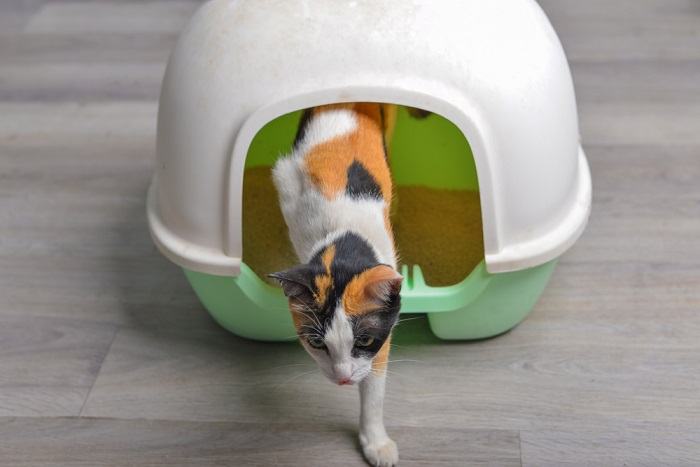
Offer at least one litter box per cat in the household, plus one extra.
If you have more than one cat provide a litter box for each cat in the household, plus one extra. This should keep cleaning schedules the same as already discussed. However, you might find that several cats prefer to use the same litter box, in which case the litter will need to be changed more often—weekly if you use clumping litter, and potentially every few days with non-clumping litter.
Cats usually urinate up to four times daily and pass feces once. This will differ between individuals though, and can be affected by age, diet, ambient temperature, fluid intake, and medications. More frequent litter changes are needed for cats with medical issues causing them to produce more urine or feces than normal, such as diabetes, kidney disease, or inflammatory bowel disease.
Keeping a close eye on your cat’s litter box can alert you to changes in the amount of pee and poop they are producing, any change from normal should be checked out by their veterinarian.
Using Scents To Cover Up Smells
Cats have a very strong sense of smell, and have 40 times more scent receptors in their noses than humans do. This makes them very sensitive to strong odors from cleaning chemicals, litter deodorizing products, and scented litters, so using these products can put them off using the litter box completely.
Litter trays won’t smell if cleaned out appropriately, and no product is a substitute for daily scooping and regular litter changes.
A Dirty Litter Box Can Be Dangerous
Speedy removal of poop from the litter box can help reduce the chances of diseases spreading between members of the household. Feline feces can harbor bacteria, viruses, and parasites, which can infect other cats, and sometimes people, too.
Cats are at risk of picking up infections when they groom their paws after using the litter box, people are at risk when they empty and clean litter boxes. Some examples of infections that can be passed on in cat feces are:
- Campylobacter
- Salmonella
- Coccidia
- Giardia
- Feline coronavirus
- Toxoplasmosis
An important disease to be aware of is toxoplasmosis, caused by the parasite Toxoplasma gondii. Toxoplasmosis in people and cats is usually a mild illness that can go completely unnoticed, but it is particularly dangerous for people with suppressed immune systems, and unborn babies if women are infected during pregnancy. Cats can be infected by hunting, eating raw or undercooked meat, or through contact with contaminated feces.
Eggs (oocysts) are passed in the cat’s feces, and take a few days to change (sporulate) to the infective form of the parasite. You can help keep everyone safe by scooping feces daily, so the oocysts don’t have a chance to become infective in the litter box. To be extra cautious, pregnant women and people with compromised immune systems should avoid handling litter trays if possible.
Can Not Changing Cat Litter Enough Cause Behavioral Issues?
Imagine the flush is broken on your toilet, but you have no choice but to use it for several days—not a pleasant thought at all! This is the situation faced by cats when their litter boxes are not scooped and cleaned out often enough, and remember, they have to stand in the litter when they do their business.
Cats are well known for being fastidiously clean, so if their litter boxes aren’t up to scratch they might opt to go somewhere else more appealing instead (known as inappropriate elimination, or house soiling). Unfortunately, the alternative location in the house is rarely acceptable to their owner, so keeping their trays clean is vitally important.
Are There Any Easier Ways To Maintain a Clean Litter Box?
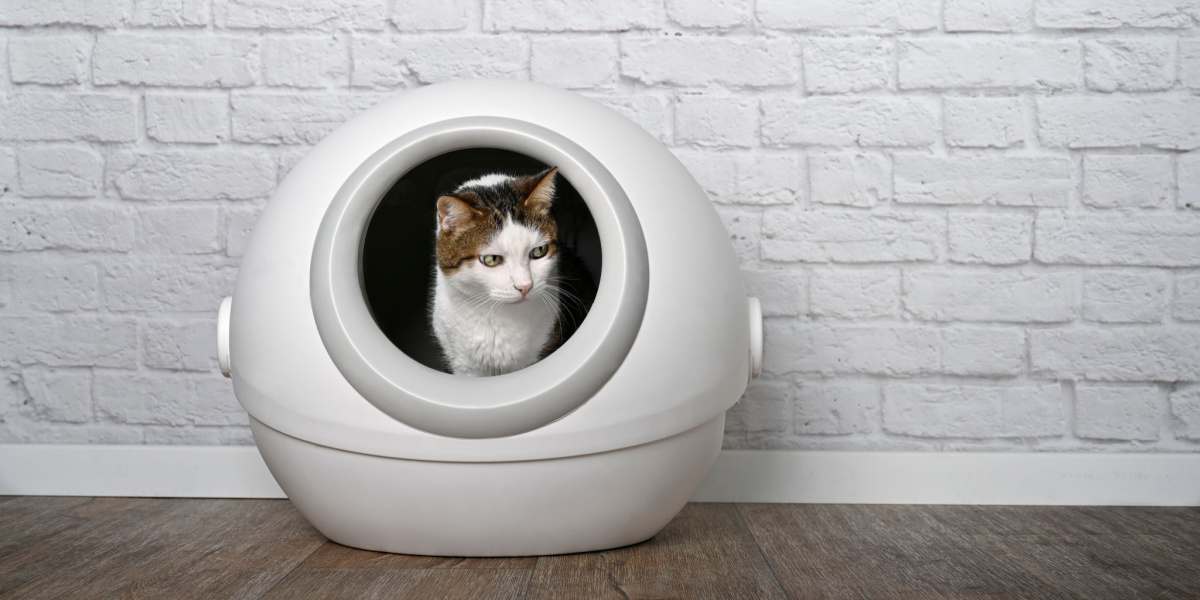
Automatic litter boxes take care of the daily scooping for you, but you still need to clean them out completely every month or so.
We all know that life can be busy, so pet owners often look for easier ways to maintain a clean litter box. Some people use polythene tray liners for the litter box to make emptying it quicker and easier. However, many cats don’t like plastic liners as they catch their claws in them, and it might put them off using the tray altogether.
Another option to consider is investing in a self-cleaning litter box. Some cats can find the noises and random movements these make off-putting, but they can be a useful addition to some households.
Cats are meticulously clean animals, and it is the responsibility of cat owners to ensure they keep their pet’s toileting area clean and tidy by regularly changing the cat litter. Regardless of litter type, the litter box should have any waste scooped out at least twice daily. Clumping litters only need a full clean and complete change of litter every two to four weeks, unless you have several cats choosing to use the same litter box.
Non-clumping litters are good at absorbing cat urine, but require the litter box to be fully emptied and cleaned more frequently (usually once a week). Failure to change the litter often enough can result in cats toileting in other areas of the house and can risk passing on infections to other members of the household (including people).
Using strongly scented litter or litter deodorizers is no substitute for good litter box maintenance, but some owners may find self-cleaning litter boxes helpful to save time in their schedules.
Also Read: The 6 Best Non-Tracking Cat Litters
-
Carney HC, Sadek TP, Curtis T, et al. (2014). AAFP and ISFM guidelines for diagnosing and solving house-soiling behavior in cats. J Feline Med Surg; 16(7):579-598.
-
Dubey JP, Ferreira LR, Martins J, Jones JL. (2011). Sporulation and survival of Toxoplasma gondii oocysts in different types of commercial cat litter. J Parasitol. 97(5):751-4. doi: 10.1645/GE-2774.1. PMID: 21539466.
-
https://www.cats.org.uk/
-
https://icatcare.org/
-
https://www.petmd.com/
